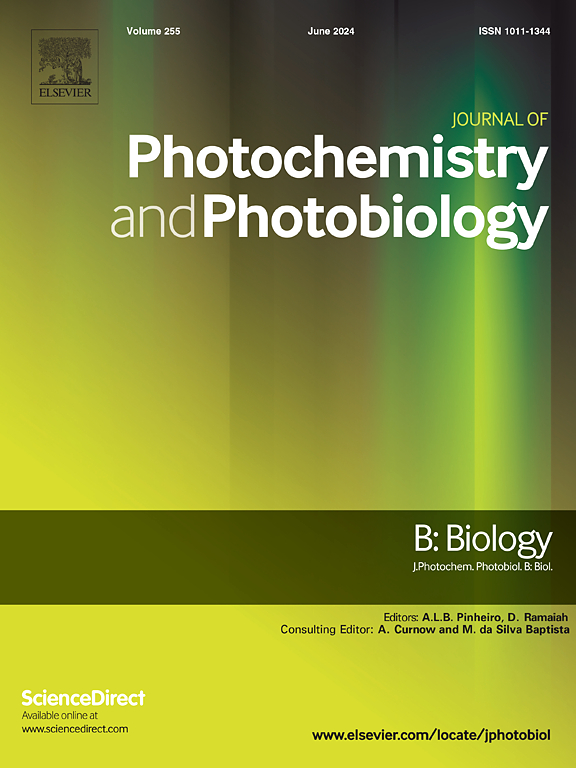Comparative analysis of femtosecond, picosecond, and nanosecond laser techniques for transseptal puncture: An in vitro study with pathological correlation
IF 3.7
2区 生物学
Q2 BIOCHEMISTRY & MOLECULAR BIOLOGY
Journal of photochemistry and photobiology. B, Biology
Pub Date : 2025-02-27
DOI:10.1016/j.jphotobiol.2025.113138
引用次数: 0
Abstract
Background
Advanced precision laser technologies for transseptal puncture are still under exploration. Femtosecond lasers, renowned for their high precision and minimal collateral damage, exhibit significant potential in transseptal puncture applications.
Objective
This study investigated the feasibility, effectiveness and pathological effects of femtosecond, picosecond, and nanosecond lasers for transseptal puncture in vitro.
Methods
Three different pulsed laser systems (femtosecond, picosecond, and nanosecond) were utilized for atrial septal puncture in fresh porcine hearts. The femtosecond laser operated at 1064 nm wavelength with 179 fs pulse width and 500 kHz repetition rate; the picosecond laser at 1962 nm with 52 ps pulse width and 60 MHz repetition rate; and the nanosecond laser at 1064 nm with 70 ns pulse width and 60 kHz repetition rate. With a focused spot size of approximately 100 μm, the power density ranged from 25.50 to 51.00 kW/cm2 (corresponding to energy densities of 0.05–0.10 J/cm2 for femtosecond, 424.40–848.80 μJ/cm2 for picosecond, and 0.42–0.85 J/cm2 for nanosecond lasers). Scanning diameters varied from 0.50 to 3.00 mm at a constant speed of 1 mm/s. Measurements of puncture diameter and thermal damage were taken using a digital optical microscope, with pathological examination evaluating tissue structure and injury extent. Multiple linear regression models were used to evaluate the effects of laser types, power, and scanning diameter on puncture outcomes. P < 0.05 was considered statistically significant.
Results
Using a focused spot size of 100 μm at power densities of 25.50–51.00 kW/cm2 (2.0–4.0 W), the femtosecond laser (500 kHz, 0.05–0.10 J/cm2) and picosecond laser (60 MHz, 424.40–848.80 μJ/cm2) achieved complete penetration across 0.50–3.00 mm scanning diameters, with puncture diameters of 0.51–3.02 mm and 0.51–3.01 mm respectively. The nanosecond laser (60 kHz, 0.42–0.85 J/cm2) penetrated only at 0.50 mm scanning diameter and partially at 1.00 mm (3 W–4 W), with significantly smaller diameters (P < 0.001). Multiple regression showed scanning diameter primarily determined puncture size (β = 0.992, P < 0.001), while both power (β = 1.798, P = 0.002) and scanning diameter (β = 2.604, P < 0.001) affected thermal damage, with nanosecond (β = 6.515, P = 0.017) and picosecond lasers (β = 5.595, P = 0.039) showing greater thermal effects than femtosecond laser. Histologically, thermal damage progressed from minimal carbonization at 2 W to moderate-severe eosinophilic degeneration at 4 W…
Conclusions
Transseptal puncture using laser systems demonstrated feasibility, particularly with femtosecond laser showing favorable outcomes in precision and thermal control under specified parameters, exhibit significant clinical potential. Further studies are needed to investigate the underlying mechanisms.
Key messages
What is already known about this subject? Femtosecond lasers, characterized by their high peak power and minimal thermal damage, are expected to have potential clinical applications in transseptal puncture techniques.
What does this study add? The effects of femtosecond, picosecond, and nanosecond lasers on ex vivo porcine atrial septum puncture were studied at varying power levels and puncture diameters. The results showed that femtosecond lasers had superior puncture capabilities compared to nanosecond lasers, with significantly higher thermal damage observed in the nanosecond laser.
How might this impact on clinical practice? Ex vivo experiments with advanced lasers, particularly femtosecond lasers, have shown promising clinical feasibility. We will plan to pursue further research based on current findings.
飞秒、皮秒和纳秒激光穿刺技术的比较分析:与病理相关性的体外研究
背景先进的精密激光穿刺技术仍处于探索阶段。飞秒激光以其高精度和最小附带损伤而闻名,在经隔膜穿刺应用中表现出巨大的潜力。目的探讨飞秒、皮秒、纳秒激光体外穿刺的可行性、有效性及病理效果。方法采用飞秒、皮秒、纳秒三种脉冲激光系统对新鲜猪心脏进行房间隔穿刺。飞秒激光器工作波长为1064 nm,脉冲宽度为179 fs,重复频率为500 kHz;1962 nm、52 ps脉宽、60 MHz重复频率的皮秒激光器;1064 nm的纳秒激光,脉冲宽度70 ns,重复频率60 kHz。聚焦光斑尺寸约为100 μm,功率密度范围为25.50 ~ 51.00 kW/cm2(对应于飞秒能量密度为0.05 ~ 0.10 J/cm2,皮秒能量密度为424.40 ~ 848.80 μJ/cm2,纳秒能量密度为0.42 ~ 0.85 J/cm2)。扫描直径范围为0.50 ~ 3.00 mm,扫描速度为1mm /s。采用数码光学显微镜测量穿刺直径和热损伤,病理检查评估组织结构和损伤程度。采用多元线性回归模型评估激光类型、功率和扫描直径对穿刺结果的影响。P & lt;0.05认为有统计学意义。结果在功率密度为25.50 ~ 51.00 kW/cm2 (2.0 ~ 4.0 W)、聚焦光斑尺寸为100 μm的情况下,飞秒激光(500 kHz, 0.05 ~ 0.10 J/cm2)和皮秒激光(60 MHz, 424.40 ~ 848.80 μJ/cm2)在扫描直径0.50 ~ 3.00 mm范围内实现了完全穿透,穿刺直径分别为0.51 ~ 3.02 mm和0.51 ~ 3.01 mm。纳秒激光(60 kHz, 0.42-0.85 J/cm2)仅在0.50 mm扫描直径处穿透,部分穿透1.00 mm (3 W - 4 W),直径明显较小(P <;0.001)。多元回归显示扫描直径主要决定穿刺大小(β = 0.992, P <;0.001),而功率(β = 1.798, P = 0.002)和扫描直径(β = 2.604, P <;0.001)影响热损伤,其中纳秒激光(β = 6.515, P = 0.017)和皮秒激光(β = 5.595, P = 0.039)的热效应大于飞秒激光。在组织学上,热损伤从2w时的最小碳化发展到4w时的中重度嗜酸粒细胞变性。结论:激光系统经间隔穿刺是可行的,特别是飞秒激光在特定参数下的精度和热控制方面具有良好的效果,具有重要的临床潜力。需要进一步的研究来调查潜在的机制。关于这个主题我们已经知道了什么?飞秒激光具有峰值功率高、热损伤小的特点,有望在经隔膜穿刺技术中有潜在的临床应用。这项研究补充了什么?研究了飞秒、皮秒和纳秒激光在不同功率水平和穿刺直径下对离体猪房间隔穿刺的影响。结果表明,与纳秒激光相比,飞秒激光具有更强的穿刺能力,并且在纳秒激光中观察到更大的热损伤。这对临床实践有何影响?先进激光器的体外实验,特别是飞秒激光器,已经显示出有希望的临床可行性。我们将计划根据目前的发现进行进一步的研究。
本文章由计算机程序翻译,如有差异,请以英文原文为准。
求助全文
约1分钟内获得全文
求助全文
来源期刊
CiteScore
12.10
自引率
1.90%
发文量
161
审稿时长
37 days
期刊介绍:
The Journal of Photochemistry and Photobiology B: Biology provides a forum for the publication of papers relating to the various aspects of photobiology, as well as a means for communication in this multidisciplinary field.
The scope includes:
- Bioluminescence
- Chronobiology
- DNA repair
- Environmental photobiology
- Nanotechnology in photobiology
- Photocarcinogenesis
- Photochemistry of biomolecules
- Photodynamic therapy
- Photomedicine
- Photomorphogenesis
- Photomovement
- Photoreception
- Photosensitization
- Photosynthesis
- Phototechnology
- Spectroscopy of biological systems
- UV and visible radiation effects and vision.

 求助内容:
求助内容: 应助结果提醒方式:
应助结果提醒方式:


